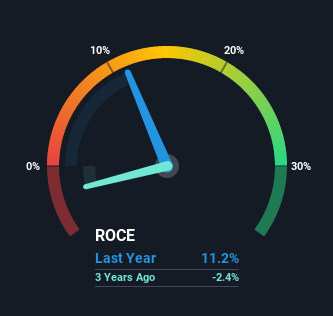- Singapore
- /
- Personal Products
- /
- SGX:AZT
NutryFarm International (SGX:AZT) Shareholders Will Want The ROCE Trajectory To Continue

To find a multi-bagger stock, what are the underlying trends we should look for in a business? Ideally, a business will show two trends; firstly a growing return on capital employed (ROCE) and secondly, an increasing amount of capital employed. Ultimately, this demonstrates that it's a business that is reinvesting profits at increasing rates of return. With that in mind, we've noticed some promising trends at NutryFarm International (SGX:AZT) so let's look a bit deeper.
Understanding Return On Capital Employed (ROCE)
For those that aren't sure what ROCE is, it measures the amount of pre-tax profits a company can generate from the capital employed in its business. Analysts use this formula to calculate it for NutryFarm International:
Return on Capital Employed = Earnings Before Interest and Tax (EBIT) ÷ (Total Assets - Current Liabilities)
0.11 = HK$14m ÷ (HK$240m - HK$112m) (Based on the trailing twelve months to June 2021).
Thus, NutryFarm International has an ROCE of 11%. That's a relatively normal return on capital, and it's around the 13% generated by the Personal Products industry.
See our latest analysis for NutryFarm International

Historical performance is a great place to start when researching a stock so above you can see the gauge for NutryFarm International's ROCE against it's prior returns. If you'd like to look at how NutryFarm International has performed in the past in other metrics, you can view this free graph of past earnings, revenue and cash flow.
What Does the ROCE Trend For NutryFarm International Tell Us?
We're delighted to see that NutryFarm International is reaping rewards from its investments and has now broken into profitability. The company was generating losses five years ago, but now it's turned around, earning 11% which is no doubt a relief for some early shareholders. Additionally, the business is utilizing 37% less capital than it was five years ago, and taken at face value, that can mean the company needs less funds at work to get a return. The reduction could indicate that the company is selling some assets, and considering returns are up, they appear to be selling the right ones.
On a side note, we noticed that the improvement in ROCE appears to be partly fueled by an increase in current liabilities. Effectively this means that suppliers or short-term creditors are now funding 47% of the business, which is more than it was five years ago. Given it's pretty high ratio, we'd remind investors that having current liabilities at those levels can bring about some risks in certain businesses.
The Bottom Line On NutryFarm International's ROCE
In the end, NutryFarm International has proven it's capital allocation skills are good with those higher returns from less amount of capital. And since the stock has fallen 54% over the last five years, there might be an opportunity here. So researching this company further and determining whether or not these trends will continue seems justified.
Since virtually every company faces some risks, it's worth knowing what they are, and we've spotted 5 warning signs for NutryFarm International (of which 3 are a bit unpleasant!) that you should know about.
If you want to search for solid companies with great earnings, check out this free list of companies with good balance sheets and impressive returns on equity.
If you're looking to trade NutryFarm International, open an account with the lowest-cost platform trusted by professionals, Interactive Brokers.
With clients in over 200 countries and territories, and access to 160 markets, IBKR lets you trade stocks, options, futures, forex, bonds and funds from a single integrated account.
Enjoy no hidden fees, no account minimums, and FX conversion rates as low as 0.03%, far better than what most brokers offer.
Sponsored ContentValuation is complex, but we're here to simplify it.
Discover if NutryFarm International might be undervalued or overvalued with our detailed analysis, featuring fair value estimates, potential risks, dividends, insider trades, and its financial condition.
Access Free AnalysisHave feedback on this article? Concerned about the content? Get in touch with us directly. Alternatively, email editorial-team (at) simplywallst.com.
This article by Simply Wall St is general in nature. We provide commentary based on historical data and analyst forecasts only using an unbiased methodology and our articles are not intended to be financial advice. It does not constitute a recommendation to buy or sell any stock, and does not take account of your objectives, or your financial situation. We aim to bring you long-term focused analysis driven by fundamental data. Note that our analysis may not factor in the latest price-sensitive company announcements or qualitative material. Simply Wall St has no position in any stocks mentioned.
About SGX:AZT
NutryFarm International
NutryFarm International Limited, an investment holding company, engages in the research, development, production, trading, and sale of nutrition, health food, and related health products in the People’s Republic of China.
Slightly overvalued with imperfect balance sheet.
Market Insights
Community Narratives




